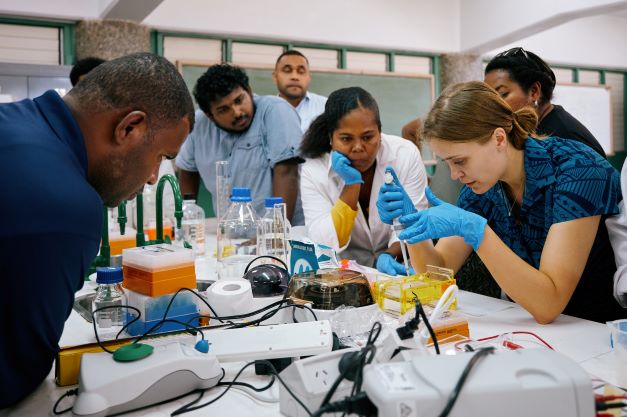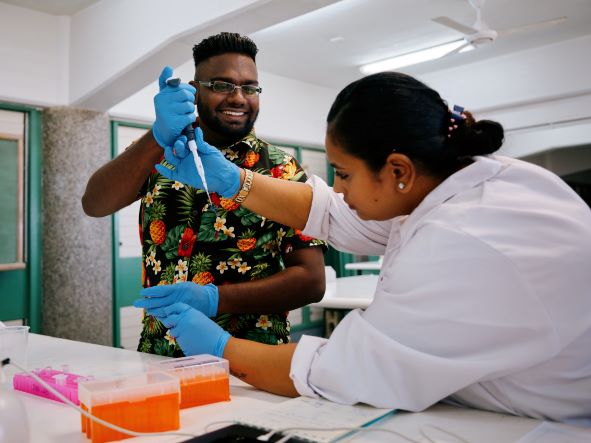Related News

Fiji is teaming up for an early warning – by development of an early detection system for marine invasive species using environmental DNA, the new frontier in science
International experts from UNESCO and Deakin University in Australia are teaming up with local experts in Suva to train local managers and technicians to detect potential marine invasive species using novel technologies such as eDNA. By filtering one liter of seawater, one can detect hundreds of species in a single sample, by just extracting and sequencing the DNA they release into the seawater.
This week the Institute of Applied Sciences at the University of the South Pacific (USP) has hosted a training course for the UNESCO project PacMAN: the Pacific Islands marine Biodiversity Alert Network project. This training course prepared participants, from across a wide range of stakeholder organisations, for sample collection and organism sorting, including taxonomy and processing for DNA extraction, eDNA and PCR analyses, as well as data analysis and data sharing protocols.
The course brought together 21 managers and technical staff from 7 organizations:
The training course was held in Fiji on the lower Laucala campus of the University of the South Pacific, and supported by the Biosecurity Authority of Fiji with funding from the Global Environment Fund (GEF 6) United Nations Development Program (UNDP) invasive alien species project and the PacMAN project of the United Nations Educational, Scientific and Cultural Organisation (UNESCO).
Principal Research Officer, Research Assessment and Development, Ministry of Fisheries Ms. Nanise Tuqiri said, “We thank the PacMAN project team for this great opportunity. Six (6) officers from the Ministry of Fisheries attended the eDNA course. It is a new tool that will complement the existing tools we are currently using to assess the status of our fisheries and contribute to sustainable fisheries management and conservation. Effective collaboration with relevant government agencies, academia, regional and international partners is crucial for implementing the eDNA tool for early detection of invasive species on our borders.”
“The Maritime Safety Authority of Fiji is committed to enhancing safer shipping and cleaner seas in Fiji. This PacMAN training is focused on identifying Marine Invasive Species through eDNA and qPCR methods. The Authority recognizes that this type of data benefits the maritime collaborative agency effort on regulating the best methods to reduce the transportation of harmful Marine Invasive Species from entering our Fiji waters,” said, Ms. Janice Manueli, Legal Officer, Maritime Safety Authority of Fiji
Meanwhile, The USP Marine Collection, School of Agriculture, Geography, Environment, Ocean and Natural Sciences curator, Mr. Kelly Brown also highlighted that, “the training course provided by the PacMAN project is a great step to develop the capacity of our local institutions that are in the forefront of monitoring invasive marine species. This was an opportunity to connect with local specialists, managers and academics that undertake similar work but do not regularly meet in the same space. Personally, I was very interested in the application of eDNA analysis in supporting our work in documenting the presence of different aquatic species in Fiji for fisheries management and conservation, and I am excited to share the knowledge gained from this training”.

SPC Aquaculture Officer, Dr. Chinthaka Hewavithrane said, “ this is the first eDNA training course ever held in Fiji. The few eDNA experts in Fiji have all been trained outside of Fiji. I did my training in Japan. The PacMAN project has been very important to optimize the protocols and the monitoring to work in marine waters of Fiji ahead of this training course”. With aquatic Biosecurity as an area of concern to the Pacific, the current capacity building program undertaken by the PacMAN project can be extended to other SPC member countries to develop their capacities in eDNA and early detection. As part of SPC, we also anticipate incorporating pathogen detection for the food safety and animal health of aquacultured and food fish species in the Pacific.
“Fiji Ports Corporation Pte Limited (FPCL) is proud to be part of the PacMAN project as it is the first of its kind in Fiji. The project aligns to FPCL vision: To be the Smart, Green Gateway for trade in the Pacific region and FPCL Green Port Masterplan in terms of its goals for capacity building such as early detection & surveillance and strengthening network with other stakeholders. Working hand in hand to ensure a safe, clean environment for all, improving operations, minimizing impact on the natural environment, and conserving the marine biodiversity of the harbor. This is just a first step, and it will be great to do similar studies at other Ports in Fiji as well as other Pacific Island Countries.” said Ms. Selai Manuel from the Fiji Ports Corporation Pte Limited
Why?
Marine biodiversity is vital for the livelihoods of pacific islanders. The health of the marine ecosystem, and in turn the people who utilize it, depends on a careful balance between the health and diversity of species normally living in the environment and human development. Introduced species are species that are not native to the local environment and can disrupt the natural balance by establishing into new areas via shipping pathways and overtaking the native species. Many marine species move around the world with international shipping traffic, attached to the hulls of vessels or in ballast water. Once the new species becomes established, it is very difficult and costly to eradicate or manage them. Therefore early detections, and regular monitoring are vital, so that any new species can be intercepted on their arrival, and the native communities can be protected.
What is eDNA?
A new method for collecting marine biodiversity information, environmental DNA (eDNA) analysis has greatly improved our ability to detect species in the environment. With simple sampling methods, and no need for extensive taxonomic expertise, eDNA can provide a snapshot of marine biodiversity at the site. In this method, one litre of water is collected from the environment, the DNA is extracted from this sample, and the species that are in the location can be analysed through PCR and sequencing of the DNA sample. This non-invasive method can provide information of the presence of hundreds of species from one sample, and help in identifying species that are difficult to detect visually.
What is PacMAN?
The Pacific islands Marine Bioinvasions Alert Network (PacMAN) project is a UNESCO project that aims to develop a marine invasive species monitoring system as well as an early-warning decision-support tool for Pacific Island States. Managed locally by USP’s Institute for Applied Science, the team is collecting samples at the Suva Port. PacMAN will be gathering marine biodiversity data by analysing DNA from these samples. The project will therefore provide vital baseline information on marine biodiversity as well as provide support to Fiji’s national management agencies to prepare and react to incursions of unwanted species coming in via international ships.
The PacMAN project runs for 3-years (2020-2023) and is funded by the Flanders Government (Kingdom of Belgium), through the Flanders UNESCO Trust Fund (FUST) for the support of UNESCO’s activities in the field of Science, and co-funded by the Richard Lounsbery Foundation.